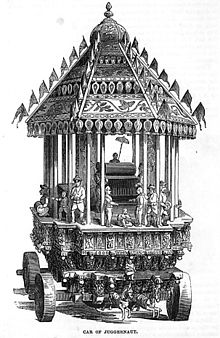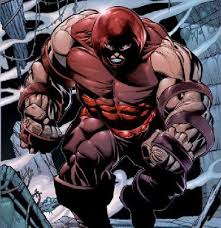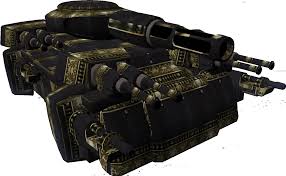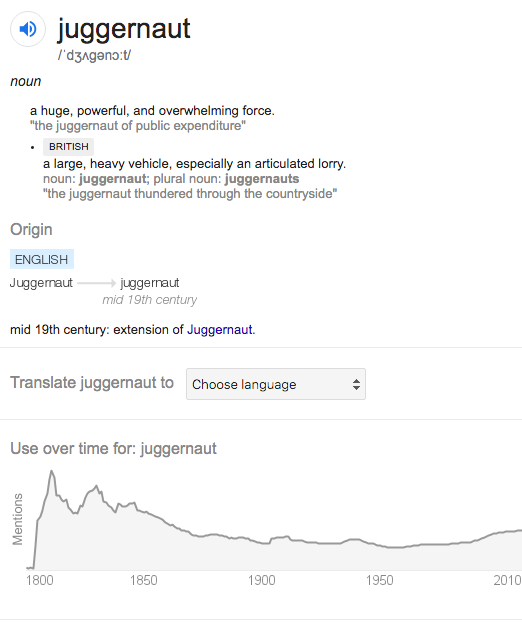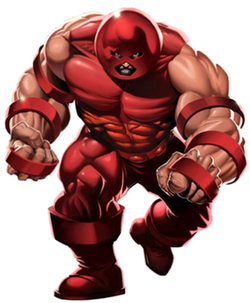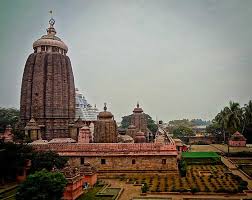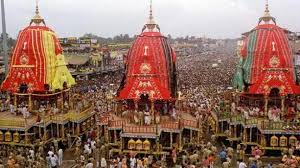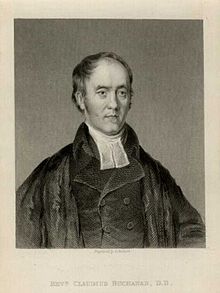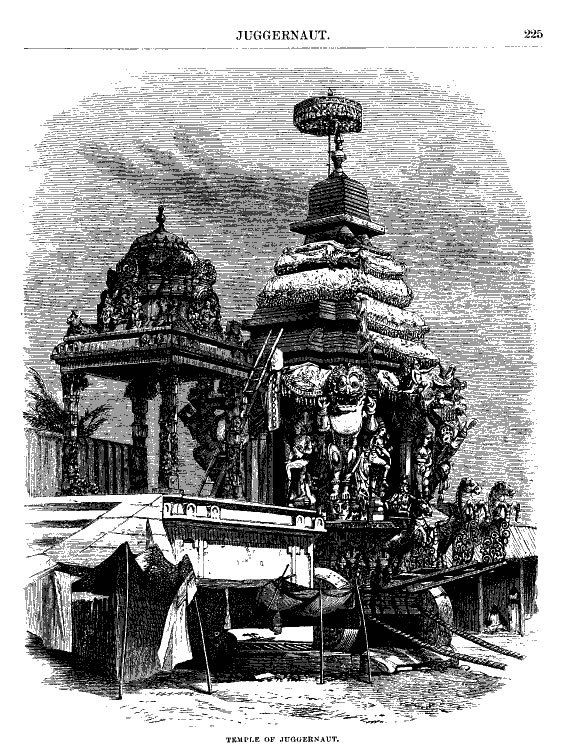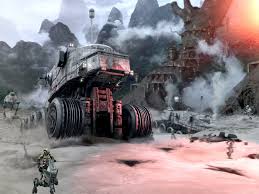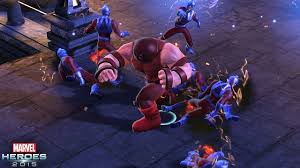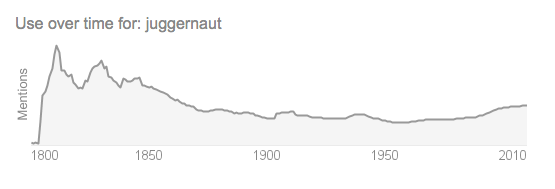Thread : Today on auspicious day of Ashadhi-beej , Lord Jagannath means "Lord of the Universe" take a tour of the town with his elder brother Balabhadra and sister Subhadra. Sharing one totally related but mostly unknown story. what's relation between these pics? #RathYatra
The origins of the "juggernaut" : People deploy the word juggernaut to describe anyone or anything that seems unstoppable, powerful, dominant. Online retailer Amazon is also a juggernaut. Tennis player Roger Federer is a juggernaut at Wimbledon. @IndiaArtHistory
In Marvel Comics there is a super-villain named Juggernaut that possess seemingly infinite strength and invincibility. The word, with its double hard g’s in the middle and the same final syllable as “astronaut,” is fun to say and connotes an individual bigger than our world.
This makes sense because the word “juggernaut” is the product of the collision between two forces, an encounter between two worlds: the English-speaking West and India. “Juggernaut” is the Anglicized name for the Hindu god Jagannath, presides over a massive temple in Puri
The most famous ritual at the Puri temple is the Rath Yatra. During the Rath Yatra the wooden forms of the gods are ceremonially placed on large towering carts, or chariots, and pulled through the streets of Puri by devotees.
Rev. Claudius Buchanan was the first British official to popularize “the Juggernaut” in both Britain and the United States in the early 1800s. Buchanan was an Anglican chaplain stationed in India and a staunch supporter of Christian missions to India. @OGSaffron
As might be expected from a missionary during the period, Buchanan’s took a negative view of Juggernaut. Buchanan was influential in introducing the Jagannath tradition and Hinduism (In negetive ways) to the American audience in early 19th-century. @iawoolford
In his letters sent back home from India, Buchanan presented Juggernaut as a dangerous, violent, and bloody religious cult. These letters were reprinted throughout Christian missionary magazines on both sides of the Atlantic.(Have that letters but will not share ) @OGSaffron
Then, in 1811, He published Christian Researches in Asia, his broad examination of the religious state of India and its need, as he saw it, for Christian missions. In Christian Researches Buchanan described devotees throwing themselves under the wheels of Juggernaut’s chariots.
He used a biblical reference to the Old Testament’s desc. of the heathen god Moloch (to whom people sacrificed their children) to explain Juggernaut to his Christian audience. Elsewhere in the book he claimed that Juggernaut “is said to smile when the libation of blood is made.”
For Buchanan, Juggernaut represented everything that was wrong with religion in India that Christianity could solve. Juggernaut, to him, was a symbol of violence, bloodshed, death, and “idolatry.” His description of Juggernaut became quite popular.
So, when the 1st American missionaries were sent to India from New England in 1812, it is no surprise that they sent back their own descriptions of Juggernaut to be published in America missionary magazines that continued to represent the god as violent and idolatrous. @kshukla778
This image of Juggernaut was so well-known in Protestant missionary circles that one missionary magazine from 1813 even used Juggernaut as a metaphor for the vice of alcohol. The figurative sense of the word has origins in mechanics comparable to figurative uses of steamroller.
Like Juggernaut, the article argued, alcohol has “shrines on the banks of almost every brook” and “four thousand self-devoted human victims, immolated every year upon its altars.” Thus, “juggernaut” started to become a term for any violent or dangerous force.
Over the next decades, as Americans learned more about India and Hindu religions, the meaning of “Juggernaut” began to split between its general use as a powerful dangerous force and its more specific reference to the Hindu god at Puri. @HinduAmericans
For example, an article in Harper’s in 1878 titled “Juggernaut” quickly informed readers that “Juggernaut” was really named “Jagannath” and then proceeded to give the history of the temple at Puri. @TrueIndoIogy
The article included a number of engravings depicting the floorplan of the temple, Jagannath’s chariot, and the forms of the god. @LostTemple7 @Squirrel_Soul
Unlike the earlier missionary representations, the article in Harper’s sought to inform readers about the history of Jagannath and explain what devotees did and why they did it. @Sea_wave24 @Lavishly_cursed @idreamofghouls @prankies @sinister_arushi @kshukla778 @iawoolford
Juggernaut” continued to be used as a reference to Jagannath, but its meaning was increasingly separated from any reference to the Hindu god. Use of the proper “Juggernaut” peaked in the early nineteenth century, while the use of the lowercase “juggernaut” slowly grew.
By the 1930s, an anti-communist book labeled communism “the red juggernaut.” In 1963,The Juggernaut made his first appearance as a villain in Marvel’s X-Men comics. Juggernaut no longer had anything to do with the temple in India, but it still represented power,violence,death.
Word “Juggernaut” teaches an important lesson. From the beginning, “Juggernaut” and “Jagannath” were not the same thing. The process of Anglicization and translation that Buchanan and others engaged in meant that “Juggernaut” was a product of the British and American imagination.
To say that Christian missionaries “misrepresented” or “misunderstood” Jagannath would be putting it too softly. They imagined Juggernaut as a foil, an Other, against which they could advocate for Christian missions. @HinduAmericans @noconversion
The missionary image of Juggernaut in the 1800s tells us more about the fears and values of Protestant missionaries than it does anything about people in India. For two hundred years, juggernauts have rolled on in American imaginations. @TrueIndoIogy
As “Juggernaut” spread beyond missionary magazines and became the lower case “juggernaut,” the Christian missionary image of an “idol” on a chariot rolling through the Indian streets dropped away, but the sense of a giant, powerful, violent unstoppable force moving ahead endured.
Celebrating more of this day, Here is another reference for Comic lovers
https://en.wikipedia.org/wiki/Juggernaut_(comics)
https://en.wikipedia.org/wiki/Nothing_Can_Stop_the_Juggernaut
https://en.wikipedia.org/wiki/Juggernaut_(comics)
https://en.wikipedia.org/wiki/Nothing_Can_Stop_the_Juggernaut
The figurative sense of the English word, with the idea of "something that demands blind devotion or merciless sacrifice" became common in the mid-19th century. For example, it was used to describe the out-of-control character Hyde in The Strange Case of Dr. Jekyll and Mr. Hyde.
Bill Wilson in Twelve Steps and Twelve Traditions of Alcoholics Anonymous describes "self-sufficiency" in society at large as being a "bone-crushing juggernaut whose final achievement is ruin".
http://www.rochrecovery.org/JuggernautSelfWill.html
http://www.rochrecovery.org/JuggernautSelfWill.html
Many speakers and writers apply the term to a large machine, or collectively to a team or group of people working together (such as a highly successful sports team or corporation), or even a growing political movement led by a charismatic leader.
For example title of this article perfectly utilize the same word to describe overwhelming control. https://www.moneycontrol.com/news/business/modi-juggernaut-steamrolls-opposition-focus-now-on-bjps-unfinished-economic-agenda-4014221.html

 Read on Twitter
Read on Twitter